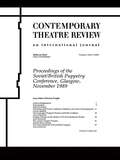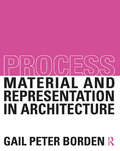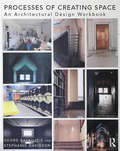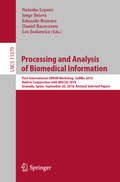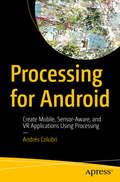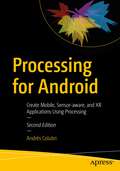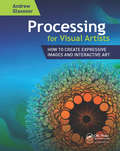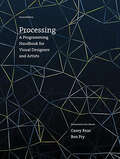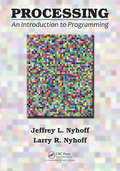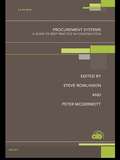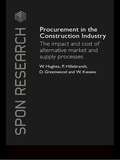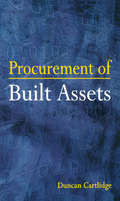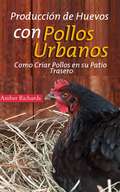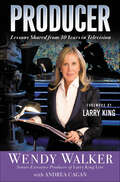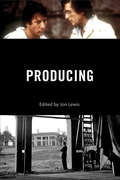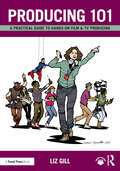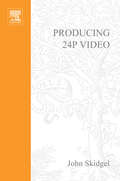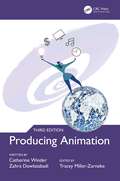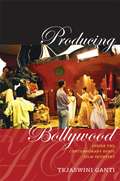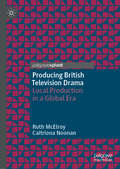- Table View
- List View
Process Control for Sheet-Metal Stamping
by Yongseob Lim Ravinder Venugopal A Galip UlsoyProcess Control for Sheet-Metal Stamping presents a comprehensive and structured approach to the design and implementation of controllers for the sheet metal stamping process. The use of process control for sheet-metal stamping greatly reduces defects in deep-drawn parts and can also yield large material savings from reduced scrap. Sheet-metal forming is a complex process and most often characterized by partial differential equations that are numerically solved using finite-element techniques. In this book, twenty years of academic research are reviewed and the resulting technology transitioned to the industrial environment. The sheet-metal stamping process is modeled in a manner suitable for multiple-input multiple-output control system design, with commercially available sensors and actuators. These models are then used to design adaptive controllers and real-time controller implementation is discussed. Finally, experimental results from actual shop floor deployment are presented along with ideas for further improvement of the technology. Process Control for Sheet-Metal Stamping allows the reader to design and implement process controllers in a typical manufacturing environment by retrofitting standard hydraulic or mechanical stamping presses and as such will be of interest to practising engineers working in metal-working, automotive and aeronautical industries. Academic researchers studying improvements in process control and how these affect the industries in which they are applied will also find the text of value.
Process of the Soviet/British: Conference On Soviet-british Puppet Theatre : Selected Papers
by KnightFirst Published in 1997. Routledge is an imprint of Taylor & Francis, an informa company.
Process: Material and Representation in Architecture
by Gail Peter BordenThis book examines the interrelationship of representational methods and material systems as fundamental drivers of the design process. Identifying four primary categories of representational logics - point, line, surface, mass - each category is illustrated through four precedent projects that deploy iterative material sensibilities. As a collection, this text provides a comprehensive categorization of the architectural design process. Through the comprehensive definition of categorical typologies, it illustrates the collective capability of this conceptual methodology. By unpacking projects through their specific design devices, the collective analysis reveals the impact of material techniques and methods of representation as a generative tool. Broad in scope, it identifies and uniformly analyses some of the most significant projects from the last century, including: UK Pavilion Shanghai - Heatherwick Studio, Shanghai,China Gatehouse - Office dA, Beijing, China Maison Colonial - Jean Prouve, France/Africa de Young Museum - Herzog and de Meuron, California USA Montreal Expo 67 - Buckminster Fuller, Montreal, Canada Jean Marie Tjibou Cultural Center – RPBW, Noumea, Indonesia House III - Peter Eisenman, New York, USA Barcelona Pavilion - Mies van der Rohe, Barcelona, Spain Tel Aviv - Scott Cohen, Tel Aviv, Israel Los Manantiales - Felix Candella, Mexico City, Mexico Yokahama Terminal – FOA, Yokahama, Japan Pantheon, Rome, Italy Tres Grand Bibliotheque - Rem Koolhaas, OMA, Paris, France Brother Claus Field Chapel - Peter Zumthor, Switzerland Embryonic House- Greg Lynn Richly illustrated with consistent, clear and precise line drawings, the book presents a series of iconic precedents through a unique analytical and graphic sensibility.
Processed Lives: Gender and Technology in Everyday Life
by Jennifer Terry Melodie CalvertConsiders how the terms of gender are embodied in technologies, and conversely, how technologies shape our notions of gender. The contributors explore the complex territory between the lust for, and the fear of, technology, commenting on the ambivalence women experience in relation to machines. Discussing topics such as embryonic fertilization, the virtual female, networking women, the sexuality of computers, surveillance systems, UFOs, and the emancipation of Barbie, rocessed Lives offers a provocative, visually rich critical approach to th multifaceted relationships between masculinity, femininity and machines. Contributors: Barbie Liberation Organization, Ericka Beckman, Lisa Cartwright, Gregg Bordowitz, Sara Diamond, Judith Halberstam, Evelynn Hammonds, Kathy High, David Horn, Ira Livingston, Bonita Makuch, Margaret Morse, Soheir Morsy, Liss Platt, B Ruby Rich, Connie Samaras, Joya Saunders, Julia Scher, Andrea Slane, Mary Ellen Strom, Christime Tamblyn, Nina Wakeford.
Processes of Creating Space: An Architectural Design Workbook
by Georg Rafailidis Stephanie DavidsonProcesses of Creating Space is a workbook for beginning designers that shows how to generate space with user experiences in mind. It explains how to keenly perceive your world and seamlessly integrate architectural representation into your design process. The book uses two main strategies, blending the design process with material processes and media techniques and ‘experiential typologies’ - emphasising first-hand experience of space. Five highly experimental assignments explore the interwoven relationship between design process and design tools, to help you learn when to incorporate writing, architectural photography, macro photography, orthographic projection, perspective projection, hand-drawing, CAD, mass modelling, hot wire foam cutting, 3D modelling, multi-part plaster mold making, slip casting, plaster casting, paper casting, monocoque shell structures, working with latex, concrete, twine pulp, full-scale prototyping and more. Illustrated with more than 350 color images, the book also includes a section on material fabrication techniques and a glossary of technical terms. An eResource containing downloadable essays, stop-motion videos, sample schedules, and supplementary information can be found here: www.routledge.com/9781138903685
Processing and Analysis of Biomedical Information: First International SIPAIM Workshop, SaMBa 2018, Held in Conjunction with MICCAI 2018, Granada, Spain, September 20, 2018, Revised Selected Papers (Lecture Notes in Computer Science #11379)
by Leo Joskowicz Natasha Lepore Jorge Brieva Eduardo Romero Daniel RacoceanuThis book constitutes the refereed proceedings of the First International SIPAIM Workshop on Processing and Analysis of Biomedical Information, SaMBa 2018, held in conjunction with MICCAI 2018, in Granada, Spain, in September 2018. The 14 full papers presented were carefully reviewed and selected for inclusion in this volume. The papers cover the following topics: Medical imaging, Digital pathology, E-health, and Motor analysis and biosignals. The purpose was to present success stories of science, research and innovation stemming from Latin American and to encourage the formation of international academic networks in biomed- ical research with a strong component in medical information processing.
Processing for Android: Create Mobile, Sensor-Aware, and VR Applications Using Processing
by Andrés ColubriLearn how to use the Processing programming language and environment to create Android applications with ease. This book covers the basics of the Processing language, allowing users to effectively program interactive graphics in 2D and 3D. It also details the application of these techniques to different types of Android devices (smartphones, tablets, wearables and smartwatches). Processing for Android walks you through the steps of taking an initial idea to a final app. With this book, you will be able to write engaging apps with interactive visuals driven by motion and location information obtained from the device’s sensors; including health data from the wearer, like step count and heart rate. An advantage of Processing for Android over more complex programming environments is the ability for users to focus on the interactions and visual output of their code rather than in the implementation details of the Android platform. This book goes through a comprehensive series of hand-on projects, ranging from simple sketches to more complex projects involving sensors and integration with larger apps. It also covers important aspects such as exporting your Processing projects as signed apps are ready to upload to the Google Play store and be share with the world!What You'll LearnWrite apps and live wallpapers for smartphones and tabletsDesign and implement interactive watch facesCreate Virtual Reality experiences for Cardboard devicesIntegrate Processing sketches into larger apps and Android StudioExport projects as completed apps ready to distribute through Google Play StoreWho This Book Is ForArtists, designers, students, researchers, and hobbyists who are not necessarily Android experts, but are looking to write mobile apps that make creative use of interactive graphics, sensor data, and virtual reality.
Processing for Android: Create Mobile, Sensor-aware, and XR Applications Using Processing
by Andrés ColubriLearn how to use the Processing programming language and environment to create Android applications with ease. This book covers the basics of the Processing language, allowing users to effectively program interactive graphics in 2D, 3D, and Extended Reality (XR). It also details the application of these techniques to different types of Android devices (smartphones, tablets, wearables, and smartwatches). This updated edition walks you through the entire process of creating an app, from the initial idea to release of the final app via the Google Play App Store. Over the course of the book, you’ll learn to write engaging apps driven by user interaction and sensor data. A comprehensive series of hands-on projects, ranging from simple sketches to more complex projects involving shaders, VR, and AR will give you the firsthand experience you need to begin developing your own projects. And once you have your Processing projects completed, you’ll be able to upload them to the Google Play store to be shared with the world! What You Will Learn Write apps and live wallpapers for smartphones and tabletsDesign and implement interactive watch facesCreate Extended Reality (VR/AR) experiencesIncorporate GLSL shaders into your Processing appsIntegrate Processing sketches into larger apps and Android StudioLearn how to write your own libraries to share with the communityExport projects as completed apps ready to distribute through Google Play Store Who This Book Is For Artists, designers, students, researchers, and hobbyists who are not necessarily Android experts, but are looking to write mobile apps that make creative use of interactive graphics, sensor data, and extended reality.
Processing for Visual Artists: How to Create Expressive Images and Interactive Art
by Andrew GlassnerWalk with veteran author Andrew Glassner; see exactly how each of his pieces evolves, including the mistakes he's made along the way (and how to fix them!), and the times when he changed direction. As your knowledge and skills grow, you'll understand why Processing is such a powerful tool for self-expression. It offers a 21st-century medium for expressing new ideas. This book gives you everything you need to know to explore new frontiers in your own images, animations, and interactive experiences.
Processing, second edition: A Programming Handbook for Visual Designers and Artists
by Ben Fry Casey ReasThe new edition of an introduction to computer programming within the context of the visual arts, using the open-source programming language Processing; thoroughly updated throughout. The visual arts are rapidly changing as media moves into the web, mobile devices, and architecture. When designers and artists learn the basics of writing software, they develop a new form of literacy that enables them to create new media for the present, and to imagine future media that are beyond the capacities of current software tools. This book introduces this new literacy by teaching computer programming within the context of the visual arts. It offers a comprehensive reference and text for Processing (www.processing.org), an open-source programming language that can be used by students, artists, designers, architects, researchers, and anyone who wants to program images, animation, and interactivity. Written by Processing's cofounders, the book offers a definitive reference for students and professionals. Tutorial chapters make up the bulk of the book; advanced professional projects from such domains as animation, performance, and installation are discussed in interviews with their creators.This second edition has been thoroughly updated. It is the first book to offer in-depth coverage of Processing 2.0 and 3.0, and all examples have been updated for the new syntax. Every chapter has been revised, and new chapters introduce new ways to work with data and geometry. New “synthesis” chapters offer discussion and worked examples of such topics as sketching with code, modularity, and algorithms. New interviews have been added that cover a wider range of projects. “Extension” chapters are now offered online so they can be updated to keep pace with technological developments in such fields as computer vision and electronics.InterviewsSUE.C, Larry Cuba, Mark Hansen, Lynn Hershman Leeson, Jürg Lehni, LettError, Golan Levin and Zachary Lieberman, Benjamin Maus, Manfred Mohr, Ash Nehru, Josh On, Bob Sabiston, Jennifer Steinkamp, Jared Tarbell, Steph Thirion, Robert Winter
Processing: A Programming Handbook for Visual Designers and Artists
by Ben Fry John Maeda Casey ReasAn introduction to the ideas of computer programming within the context of the visual arts that also serves as a reference and text for Processing, an open-source programming language designed for creating images, animation, and interactivity.
Processing: An Introduction to Programming
by Jeffrey L. Nyhoff Larry R. NyhoffThis book demonstrates how Processing is an excellent language for beginners to learn the fundamentals of computer programming. Originally designed to make it simpler for digital artists to learn to program, Processing is a wonderful first language for anyone to learn. Given its origins, Processing enables a multimodal approach to programming instruction, well suited to students with interests in computer science or in the arts and humanities. The book uses Processing’s capabilities for graphics and interactivity in order to create examples that are simple, illustrative, interesting, and fun. It is designed to appeal to a broad range of readers, including those who want to learn to program to create digital art, as well as those who seek to learn to program to process numerical information or data. It can be used by students and instructors in a first course on programming, as well as by anyone eager to teach them self to program. Following a traditional sequence of topics for introducing programming, the book introduces key computer science concepts, without overwhelming readers with extensive detail. Additional exercises are available, as are other supplementary materials for instructors looking to introduce even more computer science concepts associated with the topics. Several online chapters are also provided that introduce slightly more advanced topics in Processing, such as two-dimensional arrays, manipulation of strings, and file input and output. The conversational style and pace of the book are based upon the authors’ extensive experience with teaching programming to a wide variety of beginners in a classroom. No prior programming experience is expected.
Procurement Systems: A Guide to Best Practice in Construction
by Peter McDermott Steve RowlinsonProcurement Systems details the whole spectrum of procurement issues in the construction industry, starting with the client /customer and running through managerial, cultural and IT-based issues. The book commences with an overveiw of previous work and a section on selection criteria is provided to enable practitioners to make their choices of procurement form. Importantly, perfromance comparisons of different procurement forms are discussed and the main emphasis of the book is to highlight best practice based on the most up-to-date research. One chapter deals specifically with developmentally orientated procurement issues in NICs (newly industrialised countries), where best practice is assessed from a different set of perspectives. The authors contributing to this book are among the most highly respected and eminent in the field.
Procurement in the Construction Industry: The Impact and Cost of Alternative Market and Supply Processes (Spon Research)
by William Hughes David Greenwood Patricia M. Hillebrandt Wisdom KwawuDo recent moves in the construction industry towards collaborative working and other new procurement procedures really make good business sense? Procurement in the Construction Industry is the result of research into this question and it includes the first rigorous categorizing of the differences between procurement methods currently in use. In the process of carrying out this research, the team has produced a comprehensive study of procurement methods which looks in detail at the relative benefits and costs of different ways of working, with sometimes surprising results. As such, it is not only a valuable guide for practitioners on the complexities of the procurement process, but also an outline of the relevance of economic theory to the construction sector.
Procurement of Built Assets
by Duncan CartlidgeThe ability to successfully procure built assets is at the heart of the construction process and in turn at the heart of the procurement process is identifying the constantly evolving needs of the construction client. Despite client criticism and a mountain of reports and statistics, spanning both the public and private sectors, until now the construction industry has failed to transform the diverse and often separate and inefficient processes of design and procurement of built assets into one single integrated production process. There are now signs however that the construction industry is beginning to transform its approach to built asset procurement and client care.This book draws heavily on the experiences and best practice of other industries and market sectors who have, just as construction is now having to do, taken a critical look at their procurement practices and techniques and the inherent waste in many traditional systems. The text includes practice-based case studies, from both the public and private sectors, to demonstrate how new procurement approaches are delivering value for money over the life cycle of built assets.This book is recommended reading for a range of students in the field of the built environment from quantity surveyors and commercial managers to architects and an essential and comprehensive guide to all construction procurement professionals seeking to familiarise themselves with the latest approaches to procurement.
Procuring Innovative Architecture
by Leon van Schaik Geoffrey LondonThe case studies in this book describe how clients’ promotion of innovative communities of practice has led to important collections of architectural works. The book provides an assessment of the effectiveness of their approaches. Architects and clients will understand what to look for as they construct their careers and their portfolios with innovation as a goal. It is taken for granted nowadays that supporting innovative architecture benefits society. In countries as diverse as Austria, Australia, Belgium, England, Japan, South East Asia, Slovenia, Spain, Switzerland and the USA, retailers, institutions, local and regional government and transport authorities have established substantial bodies of work by new and emerging architects. This books looks at what their goals are and how they have achieved them. Is it possible to promote sustainable communities of innovative practice through such patronage? Can innovation be ‘kick-started’ by importing visionary works?
Producción De Huevos Con Pollos Urbanos. Como Criar Pollos En Su Patio Trasero
by Amber Richards David GarayProducción de Huevos con Pollos Urbanos Como Criar Pollos en su Patio Trasero ¿Cree que necesita tener una granja o vivir en el campo para criar pollos? ¡Piénselo de nuevo! La crianza de pollos se ha vuelto cada vez más común en zonas urbanas y los beneficios son asombrosos. Y si a usted le preocupa pueda llegar a ser demasiado trabajo o que es mejor sólo comprar una docena en el supermercado, pues tenemos noticias para usted. Producción de Huevos con los Pollos Urbanos: Cómo Criar Pollos en su Patio Trasero resuelve todas estas conjeturas y preocupaciones comunes. Esta guía responderá las preguntas más importantes, ofreciendo un proceso de creación de un nuevo gallinero para su bandada de emplumados y al final se sentirá como un profesional. Proveer huevos frescos y orgánicos a su familia nunca ha sido tan fácil. Mejor aun sabiendo que han sido producidos en un entorno humano y que el cuidado que ha creado para usted mismo no tiene precio. Eche un vistazo a contenido del libro: Razones para Criar sus Propios Pollos Antes de Empezar a Criar Pollos ¿Qué Razas de Pollos Debería Considerar? Donde Conseguir los Pollos ¿Debería tener un Gallo? Instale un Gallinero ¿Cuántos Pollos Debería Tener? Alimente y Abreve sus Pollos Mantenga sus Pollos Saludables Precauciones Importantes de Salubridad en la Crianza de Aves de Corral Recolección y Limpieza de los Huevos El cuidado de los pollos es también un proyecto educativo de 4H para los niños. Estos amigos emplumados tienen grandes personalidades los cuales le enseñarán responsabilidad y proporcionarán oportunidades de vinculación para toda la familia. Si usted está contemplando empezar la crianza de pollos, no busques más.
Produce Your Own Damn Movie!
by Lloyd KaufmanOften low-budget filmmakers get thrown into the position of being not only the director, but their own producer. Using tips from the finest washed-up has-been producers in the business, this book will give the low-budget filmmaker practical tools for getting a movie shoot started, and keeping it going until it is supposed to end. From budgeting concerns to production-damaging acts of God, all will be discussed.
Producer: Lessons Shared from 30 Years in Television
by Andrea Cagan Wendy WalkerFor the past seventeen years, Wendy Walker has been the "woman behind the man" at Larry King Live. As King's senior executive producer, she has been responsible for landing exclusive interviews with the most important newsmakers and well-known celebrities from around the globe that have been the hallmark of CNN's iconic show.From the shocking death of Michael Jackson to the first television interview with the Watergate scandal's Deep Throat, Wendy Walker has a wealth of never-before-shared stories involving the most relevant events and people of our time.Starting as an ABC secretary over thirty years ago, she has risen through the male-dominated world of television production. Her passion, intellect, and work ethic are undeniable, but it's her heart that has always been her guide. It's with the same zeal and loving spirituality that she shares the insights gained during her long climb to the top. With empowering advice and inspirational thoughts, Wendy Walker has not only gained a lifetime of experience, but the wisdom to know that it needs to be shared.
Producing
by Mark Lynn Anderson Jon Lewis Bill Grantham Douglas Gomery Saverio Giovacchini Professor Joanna E. Rapf Professor Toby MillerOf all the job titles listed in the opening and closing screen credits, producer is certainly the most amorphous. There are businessmen (and women)-producers, writer-director- and movie-star-producers; producers who work for the studio; executive producers whose reputation and industry clout alone gets a project financed (though their day-to-day participation in the project may be negligible). The job title, regardless of the actual work involved, warrants a great deal of prestige in the film business; it is the credited producers, after all, who collect the Oscar for Best Picture. But what producers do and what they don't or won't do varies from project to project. Producing is the first book to provide a comprehensive overview of the roles that producers have played in Hollywood, from the dawn of the twentieth century to the present day. It introduces readers to the colorful figures who helped to define and reimagine the producer's role, including inventors like Thomas Edison, moguls like Darryl F. Zanuck, entrepreneurs like Walt Disney, and mavericks like Roger Corman. Readers also get an inside look at the less glamorous jobs producers have often performed: shepherding projects through many years of development, securing financial backers, and supervising movie shoots. The latest book in the acclaimed Behind the Silver Screen series, Producing includes essays written by seven film scholars, each an expert in a different period of cinema history. Together, they give readers a full picture of how the art and business of producing films has changed over time--and how the producer's myriad job duties continue to evolve in the digital era.
Producing 101: A Practical Guide to Hands-On Film & TV Producing
by Liz GillThis book offers a step-by-step exploration of a Producer’s on-set responsibilities within the context of creating a TV series or feature film.Being a successful Producer requires you to have an intimate understanding of global finances, law, union rules and negotiating. The role also requires solid filmmaking skills from scriptwriting to scheduling, casting to cutting and sound mixing to marketing. But most important of all these skills is leadership – building a team and facilitating a collection of highly trained (and often artistically temperamental) individuals to do their best collective work. This book describes best practice across geographical jurisdictions, identifying key universal principles as well as the specific and unique detail work that make a great Producer. Each chapter offers meaningful advice from experienced industry experts, useful examples including real-world templates of crucial paperwork, and preventative measures that can be implemented. Producers of all backgrounds will benefit from clear, concise writing that outlines industry standard structures, protocols and processes – and why they work.This book will prove invaluable to people starting out in their careers, but also those interested in exploring producing who come from other departments – such as Assistant Directors, Production Managers and Line Producers – and those changing formats, such as from TV to film.
Producing 24p Video: Covers the Canon XL2 and the Panasonic DVX-100a DV Expert Series
by John SkidgelProducing 24pP Video demystifies the emerging standards of film and video production and discusses the 24p video film format to help novice and experienced filmmakers alike learn how to better use the newly available DV cameras. Since the 24p frame rate closely approximates the look and feel of film, it is the speed of choice whenever a "cinematic" look is desired. 24p video also offers certain compression options that are advantageous to web and wireless delivery. This full-color book discusses the special techniques required by 24p productions - all the way through the production, from preproduction planning through post and output. Each chapter includes techniques, examples, tips, and case studies. The field techniques section features real-world setups presented as demonstrations or as tutorials. Case studies present profiles of people producing 24p projects, and the DVD includes step-by-step instructions that illustrate how to work with 24p material in NLE, compositor, DVD authoring, and audio applications.
Producing Animation 3e
by Catherine Winder Zahra DowlatabadiProducing Animation is a comprehensive guide to the production industry. Already a relied upon resource by professionals and students alike, this book covers the process from script to screen while defining the role of the producer at each phase. The second edition features new content such as sidebars on key topics from industry experts, discussions on CG, 2D and stereoscopic production processes, and an overview on marketing and distributing your project. The companion website provides access to sample tables, templates and workflow outlines for CG and 2D animation production. Key Features A complete guide to identifying, pitching, developing, and producing an animated show with detailed resources for production planning, budgeting, scheduling, tracking, delivering, marketing, and distribution. Tools to establish the best production practices for your project with insight into the inner workings of animation production at successful studios both large and smal A unique collection of the knowledge, experience, and advice of industry professionals on a wide variety of topics, from selling your project to setting up a co-production to stereoscopic filmmaking. Versatile and practical sample charts, tables and templates for CG and 2D animation production to help launch your project with solid processes and procedures
Producing Bollywood: Inside the Contemporary Hindi Film Industry
by Tejaswini GantiProducing Bollywood offers an unprecedented look inside the social and professional worlds of the Mumbai-based Hindi film industry and explains how it became "Bollywood," the global film phenomenon and potent symbol of India as a rising economic powerhouse. In this rich and entertaining ethnography Tejaswini Ganti examines the changes in Hindi film production from the 1990s until 2010, locating them in Hindi filmmakers' efforts to accrue symbolic capital, social respectability, and professional distinction, and to manage the commercial uncertainties of filmmaking. These efforts have been enabled by the neoliberal restructuring of the Indian state and economy since 1991. This restructuring has dramatically altered the country's media landscape, which quickly expanded to include satellite television and multiplex theaters. Ganti contends that the Hindi film industry's metamorphosis into Bollywood would not have been possible without the rise of neoliberal economic ideals in India. By describing dramatic transformations in the Hindi film industry's production culture, daily practices, and filmmaking ideologies during a decade of tremendous social and economic change in India, Ganti offers valuable new insights into the effects of neoliberalism on cultural production in a postcolonial setting.
Producing British Television Drama: Local Production in a Global Era
by Caitriona Noonan Ruth McElroyThis book presents a compelling case for a paradigmatic shift in the analysis of television drama production that recentres questions of power, control and sustainability. Television drama production has become an increasingly lucrative global export business as drama as a form enjoys increased prestige. However, this book argues that the growing emphasis on international markets and global players such as Netflix and Amazon Prime neglects the realities of commissioning and making television drama in specific national and regional contexts. Drawing on extensive empirical research, Producing British Television Drama demonstrates the centrality of public service broadcasters in serving audiences and sustaining the commercial independent sector in a digital age. It attends closely to three elements—the role of place in the production of content; the experiences of those working in the sector; and the interventions from cultural intermediaries in articulating and ascribing value to television drama. With chapters examining the evolution of British TV drama, as well as what might be in store in its future, this book offers invaluable insights into the UK as a major supplier of and market for television drama.

